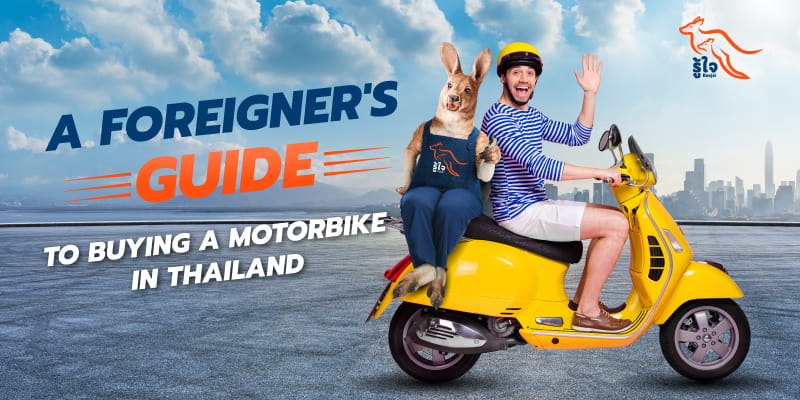
If you’re a seasoned expat looking for a more convenient mode of transportation or a long-term visitor eager to see hidden gems, owning a motorbike in Thailand offers an unparalleled sense of freedom and adventure.
But the process of buying a motorbike in Thailand can seem complex, especially for foreigners. That’s why we’ve created this comprehensive guide to walk you through every step of owning a motorcycle in the land of smiles, ensuring you ride away with the perfect bike. And as a trusted insurance provider in Thailand, we’ll also highlight the importance of having the right two-wheel coverage for your safety and financial well-being.
Why buy a motorbike in Thailand?
For many, the decision to buy a motorbike in Thailand is driven by a mix of practicality and lifestyle benefits:
- Affordability: Compared to cars, motorbikes are more budget friendly. The initial purchase price, fuel costs, and maintenance are generally much lower.
- Convenience: Moving through Thailand’s major cities, like Bangkok, can be a challenge. Motorcycles can effortlessly weave through traffic congestions and parking is also considerably easier to find.
- Accessibility: A motorbike opens up a world of exploration that might be inaccessible by cars. Traversing charming smaller soi and scenic rural paths at your own pace are easier with a two-wheeled vehicle.
Types of motorbikes available in Thailand
You will encounter a range of motorbike types in Thailand, each with its own characteristics and suitability for different needs:
Scooters (automatic)
This is the most common type you’ll see on Thai roads, with engine sizes ranging from 110cc to 150cc. Some popular models of automatic scooters include Honda Click, Yamaha Aerox, Honda PCX, Yamaha NMax, and Honda Scoopy. They are easy to handle thanks to their automatic transmission and are fuel-efficient, but for those planning long-distance travels, their power might feel limited.
Semi-automatic motorcycles
Stepping up slightly in terms of control are the semi-automatic motorcycles, with models such as the Honda Super Cub and Yamaha Spark. These bikes provide a greater sense of command for the rider compared to scooters, while still maintaining a relatively user-friendly operation. One factor to consider is that they are not as commonly found as scooters, which could potentially affect their availability in certain areas.
Manual motorcycles
For enthusiasts who prioritise complete control over their ride, manual motorcycles present a wide spectrum of choices. Engine sizes can vary dramatically, from 110cc machines to powerful, large displacement bikes like those from Harley Davidson. The distinct advantage here is the rider’s ability to precisely manage the gears, making these motorcycles well-suited for diverse terrains and longer journeys. It’s worth noting that operating a manual motorcycle requires more skill and these models often come with a higher price point.
Big bikes
The landscape of motorcycling in Thailand is also seeing a growing presence of “big bikes”, motorcycles with 400cc engine displacement or higher. If your interest lies in these more powerful machines, it’s important to note that you’d need a special big bike licence and registering your vehicle might have specific requirements compared to smaller motorbikes.

Buying a new motorbike in Thailand
If you’re leaning towards the experience of owning a brand-new motorbike in Thailand, several key steps are involved in the purchasing process.
Step 1: Choose a reputable dealer. Opting for an authorised dealer offers several advantages, including warranty coverage, after-sales service, and registration assistance.
Step 2: Explore and test ride. Visit dealerships, browse the available models, and take test rides. This will help you determine which bike suits your needs and riding style.
Step 3: Negotiate the price. Don’t hesitate to discuss pricing with the dealer to ensure you’re getting a fair deal.
Step 4: Sign the sales contract and provide documents. Once you’ve agreed on a price, you’ll sign a sales contract. You’ll also need to provide necessary identification documents, typically including copies of your passport, visa, and a Residence Certificate or other proof of address.
Step 5: Registration. Dealers often assist with the initial registration of your new motorbike in Thailand. They will guide you through any required paperwork.
Step 6: Receive the green book. After registration, you will receive the “green book” (tabien rod), the official vehicle registration document. Keep this document safe.
Choosing a new motorbike offers the peace of mind of being the first owner and having a warranty. However, a used motorcycle can be a more budget-friendly alternative, and its buying process has its own distinct considerations, which we’ll outline next.
Buying a used motorbike
Purchasing a used motorcycle in Thailand can be a cost-effective option, but it requires careful attention to detail. Here’s a guide to the process:
Step 1: Find a used motorbike. Explore various avenues like online marketplaces, expat buy-and-sell groups, or private sellers.
Step 2: Conduct a thorough inspection. Before making any decisions, examine the motorbike:
- Check for rust, dents, and scratches.
- Assess the condition of tires.
- Inspect brakes (pads, discs).
- Listen to the engine for unusual noises and check for leaks.
- Test the transmission and clutch for smooth operation.
- Evaluate the suspension during a test ride.
- Ensure all electrical components (lights, indicators) work.
- Examine the frame for any signs of damage (cracks, welds).
Step 3: Verify paperwork and due diligence. This is a critical step:
- Carefully verify that the details in the Green Book match the motorcycle’s identification number and engine number.
- Check the seller’s ID to ensure they are the rightful owner.
- Inquire and, if possible, verify that there are no outstanding taxes or fines associated with the motorbike.
Step 4: Take a test ride. Never buy a used motorcycle in Thailand without taking it for a proper test ride to assess its performance and handling.
Step 5: Negotiate the price. Once you’re satisfied with the condition and paperwork, negotiate a fair price with the seller.
Step 6: Transfer of ownership at the DLT. Visit the Department of Land Transportation (DLT) together with the seller, if possible. Bring all required documents and pay the transfer fees:
- Your passport copies, visa, and Residence Certificate.
- The seller’s identification card copies.
- The original green book.
- Signed transfer forms (available at the DLT).
Completing the transfer of ownership at the DLT ensures that you are the legal owner of the used motorcycle in Thailand. Failing to do so can lead to complications in the future, especially with insurance and resale.

Documents required to buy a motorbike in Thailand as a foreigner
- Passport: Copies of the main identification page, current visa, and most recent entry stamp into Thailand.
- Residence Certificate or Proof of Address: Obtained from Thai Immigration or your embassy. Alternatives like a copy of a Work Permit might be accepted. Digital work permits must be printed out.
- Thai driving licence: While an International Driving Permit (IDP) is useful, a Thai licence is advisable for long-term stays and insurance purposes.
- Green book (tabien rod): The vehicle registration book. It has information about the vehicle, including its registration number, and the owner’s details. If buying a used motorbike, you would need the previous owner’s green book.
Motorcycle insurance in Thailand
Protecting yourself and your vehicle with insurance is essential when riding a motorbike in Thailand. The country has one of the highest road accident rates in the world, with most involving motorcycles. Without proper insurance, you could face hefty out-of-pocket costs or legal issues if you’re in an accident.
Thai law mandates a basic form of insurance, but there are available options you can choose to ensure comprehensive coverage:
Compulsory motor insurance
Compulsory motor insurance, or Por Ror Bor, is a legally required minimum insurance for all motor vehicles in Thailand. It provides coverage for bodily injury to all parties involved, including the rider, passengers, and third-parties regardless of who’s at fault. The coverage limits are set for medical expenses, as well as for death and dismemberment. Proof of Por Ror Bor is required for renewing your road tax and registration.
Voluntary motorbike insurance
While Por Ror Bor provides basic protection, it often has limited coverage, particularly for damage to your own vehicle or liability for damage to third-party property. This is where voluntary motorcycle insurance comes in, providing more comprehensive protection. Here’s a quick overview of each:
- Type 1 motorbike insurance is the most comprehensive option, ideal for new or high-value bikes. It covers accidents (including single-vehicle crashes), third-party damage, fire, theft, and natural disasters.
- Type 2+ insurance is a more affordable alternative to type 1, covering accidents but only when another vehicle is involved. It also includes fire, theft, and flooding protection. It doesn’t cover single-vehicle crashes like type 1 does.
- Type 3+ insurance is similar to type 2+ but excludes fire and theft. It offers coverage for third-party damage and accidents involving another vehicle.
- Type 2 insurance covers fire, theft, and third-party liability, but not accident damage (whether you hit something or someone hits you).
- Type 3 insurance is the most basic and affordable voluntary policy as it only covers third-party injury and property damage. It doesn’t protect your own bike from any kind of loss or accident.
Each policy type has its pros and cons, depending on how and where you ride. For a deeper breakdown of coverage and pricing, check out our dedicated pages on each insurance type or contact our team to find the best fit for your needs.
Final thoughts
Buying and riding a motorcycle in Thailand is a practical and often exhilarating way to explore the country, but it comes with legal, safety, and insurance responsibilities. From choosing the right bike to getting the proper paperwork and insurance, each step matters.
Most importantly, ride safely. Even the best insurance can’t prevent accidents, but it can protect you when the unexpected happens. At Roojai, we offer flexible, affordable motorcycle insurance plans that cover you for more than just the basics, so you can focus on the road ahead with confidence. Visit Roojai to explore our motorcycle insurance options and befriend us on Facebook or LINE to stay updated on the latest motorbike and insurance news.



